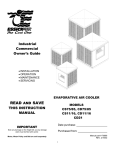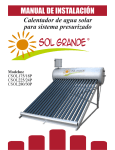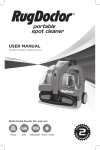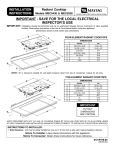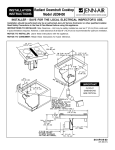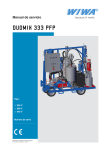Download Essick CD21 Instruction manual
Transcript
Industrial Commercial Owner’s Guide • INSTALLATION • OPERATION • MAINTENANCE • SERVICING READ AND SAVE EVAPORATIVE AIR COOLER MODELS CS11/16, CD11/16 CD21 THIS INSTRUCTION MANUAL IMPORTANT Note any damage on the freight bill, as any damage claim must be filed with carrier. Date purchase: _____________________ Purchased from: ____________________ Motor, Motor Pulley, Pump and Belt are sold separately Manual part # 70888 REV. 1/06 1 INSTALLATION OF EVAPORATIVE COOLERS PREPARATION 1. All electrical and duct work must comply with local and federal codes. 2. Make arrangements to get the cooler from ground to roof (crane, hoist, etc.). LOCATION 1. Cooler should not be mounted near exhaust openings or vent pipes where fumes and odors can be drawn into cooler. 2. Ensure mounting surface is strong enough to support the cooler. Operating weight will be much heavier than shipping weight. 3. Locate cooler so that fresh air is drawn in; air is not recirculated. ROOF MOUNT UNITS 1. Select the location, taking into account roof construction and duct requirements. If rafters are cut when the roof opening is cut, be sure to strengthen them. 2. Purchase or construct a platform to provide a level, mounting surface for the cooler. Always mount the cooler high enough to allow easy access to the drain fitting. 3. Measure cooler or use the spec sheet to determine size of platform. Platform must be located so that the discharge opening of the cooler is in line with the ductwork. On pitched roofs, the platform frame may be covered with galvanized sheet steel or other weatherproof materials. An opening or removable panel must be left to allow access to the drain fitting. On down discharge coolers the duct should be fastened to the platform collar before cooler is set in place. The duct should have a standing flange for the cooler discharge opening to fit. Flash and seal the duct and roof opening to provide weather tightness. CAUTION: TO AVOID RISK OF FIRE, ELECTRICAL SHOCK, OR SERIOUS PERSONAL INJURY, BE SURE TO DISCONNECT POWER FROM UNIT BEFORE CLEANING OR SERVICING. WARNING: TO REDUCE THE RISK OF FIRE OR SHOCK; DO NOT USE THIS FAN WITH ANY SOLID STATE SPEED CONTROL DEVICE. DUCT WORK 1. The most important rule to follow when designing duct work is: AN EVAPORATIVE COOLER DEPENDS UPON A LARGE VOLUME OF AIR COMING OUT OF THE DUCT WORK AT HIGH VELOCITY IN ORDER TO COOL PROPERLY. 2. Do not “reduce” the discharge opening of the cooler. 3. Do not undersize the duct work and make it much smaller than the discharge opening. (In most cases, air conditioning duct work is too small for coolers.) 4. Extra long ducts cause static pressure and will reduce airflow. They also pick up heat and diminish the effect of the cooled air. 5. The motor pulley may be adjusted to compensate for ductwork. 6. Sharp or abrupt bends hinder airflow. 7. Poorly designed ceiling diffusers will ruin a successful installation. Install diffusers that are designed for use with evaporative coolers. MOTOR INSTALLATION After cooler is in place and level, remove the motor from the box and inspect for shipping damage. Ensure that the motor voltage, phase and horsepower are correct. Mount motor on motor mount as shown. Mount the motor using the slots that align the motor pulley and blower pulley. BELT ADJUSTMENT An improperly adjusted belt will greatly shorten motor life. A deflection of ¾” with finger force will indicate proper adjustment. Do not use the motor pulley to adjust belt tension. Always use the motor mount to adjust the belt. 2 MOTOR PULLEY ADJUSTMENT Before installing the motor pulley, loosen the set screw on the back side of the pulley and turn the outside jaw of the pulley until it is fully closed. Position the set screw over the closest flat spot in the thread and then open the outside jaw of the pulley 4 or 5 turns. Position the set screw over the closest flat spot in the thread and retighten the set screw. Place the pulley on the motor shaft and tighten the front set screw. The CD21 coolers are equipped with double groove pulleys. OVERFLOW PIPE INSTALLATION Place the rubber washer onto the drain bushing. Slide the bushing through the drain opening, in the cooler bottom, from the top side. Screw the nut onto the bushing from under the cooler. Position the overflow tube in the bushing. CAUTION: DO NOT HOOK THIS COOLER TO A WATER SOFTENER. THIS WILL VOID THE WARRANTY. WATER CONNECTION The float mounts in a hole provided in the corner post (down draft) or front panel (side draft). The water level should remain at least ½” below the top of the overflow tube. A screw is provided in the float to adjust water level; or the float rod may be bent to adjust the level. BLEEDOFF In hard water areas, a bleed off kit may be installed to dispose of small amounts of mineralized water, allowing fresh water to replace it. Reservoir ELECTRICAL POWER 1. The installation of electrical wiring must conform to all local and federal codes and should be done by a certified electrician. 2. Connecting the motor and/or pump to the wrong voltage will void the warranty. Notice to Installer: The motor amperage must be set as close as possible to motor nameplate amps without the pump running. WARNING: To avoid risk of electrical shock, disconnect the power before opening or attempting service on this unit. WARNING: TO REDUCE THE RISK OF FIRE OR SHOCK; DO NOT USE THIS FAN WITH ANY SOLID STATE SPEED CONTROL DEVICE. WIRING DIAGRAMS Three phase; one and two speed. Motor starter to be equipped with overload relay sized to accommodate motor full load amps. Motor starters and overloads are not supplied with units. BLACK STRIPED RED BROWN MOTOR 1 3 RED GREEN 3 PUMP 115V SUPPLY PUMP SINGLE SPEED DIAGRAM 3 START UP After installing cooler and before filling with water: 1. Open windows and doors or other exhaust openings in building. 2. Turn on cooler and check amperage at the incoming white lead, using clamp on ammeter. If amperage reads above motor name plate, refer to the motor pulley adjustment instructions (page 2) and open the pulley ½ turn. Restart cooler and recheck amperage. If amperage reads below motor name plate, close the pulley ½ turn. Restart cooler and recheck amperage. 3. Turn on water to cooler and ensure that connections do not leak. 4. Fill pan to ½” below top of overflow tube and ensure that the float cuts off water completely. 5. Turn the switch to cool and check that water is coming from the water trays and that the pads are wetting evenly. There are screws at the top of the louvers to level the water trays. MAINTENANCE CAUTION: Turn off all electrical power to this unit before opening or attempting any service. Occasionally inspect your cooler for leaks, loose belt, blocked water lines, correct belt alignment or excessive residue buildup on the pads. Inspect cabinet for rust. If rust spots appear, sand and paint with a high-grade, corrosion resistant paint. OILING Lube the blower bearings twice per year- 2-3 drops per bearing. Use SAE 20W or 30W, non-detergent oil on bearings with oil cups and standard bearing grease on ball bearings. Oil the blower motor if it is equipped with oil holes. Some motors are permanently lubricated at the factory. PAD REPLACEMENT It is best to change pads at the end of the season. When old pads (covered by minerals and salts) are left in the cooler during the wet winter months, there is a greater possibility for corrosion. 1. Remove the louver from the cooler. 2. Unhook pad retainers from the sides of the louver and remove. 3. Remove the old pad and discard. 4. Clean any dirt or sediment that has built up on louver. Inspect the water tray and clean any dirt or sediment that has built up in the water slots. If louver has rust spots, sand and paint with a high-grade, corrosion resistant paint. 5. Tuck new pad into louver, ensuring that there are no gaps to allow hot air to bypass the pad 6. Replace the pad retainers. LIMITED WARRANTY This warranty is extended to the original purchaser only. It does not cover damages incurred during shipping or through accident, neglect, or abuse by the owner. Essick Air Products does not authorize any person or representative to assume any other or different liability in connection with this cooler. TERMS AND CONDITIONS OF WARRANTY The BOTTOM PAN is guaranteed against leakage due to rusting out for Five Years. All other original parts provided by Essick Air Products are warranted against defects in material or factory workmanship for One Year. EXCLUSIONS FROM THE WARRANTY Essick Air Products is not responsible for incidental or consequential damage resulting from any malfunction. Essick Air Products is not responsible for any damage occurring from the use of water softeners, chemicals, descale material, or if a higher horsepower motor than what Essick Air Products recommends is used in the unit. Essick Air Products is not responsible for the cost of service calls to diagnose cause of trouble, or labor charge to repair and/or replace parts. HOW TO OBTAIN SERVICE UNDER THIS WARRANTY Contact the Dealer where you purchased the evaporative cooler. If for any reason you are not satisfied with the response from the dealer, contact Customer Service Department: Essick Air Products Inc. 5800 Murray Street, Little Rock, Arkansas 72209. Phone 1-800-643-8341 4 CS11/16, CD11/16 & CD21 REPLACEMENT PARTS / PIEZAS DE RECAMBIO To order replacement parts, please call “The Cooler Hotline” at 1-800-643-8341. To ensure prompt service, have the following information available. Cooler Model #______________________________ Serial # ____________________________________ Manual # and Revision Date____________________ Purchased From_____________________________ 5 CS11/16, CD11/16 & CD21 REPLACEMENT PARTS / PIEZAS DE RECAMBIO CS11/16 CD11/16 & CD21 DESCRIPTION DESCRIPCIÓN PART NO. NO. DE REF. QTY. CAN. PART NO. NO. DE REF. QTY. CAN. 1 FRONT FRENTE 70697 1 N/A *** 2 BOTTOM BLOWER HOUSING (CS11/16) CUTOFF BANDEJA INFERIOR 70702 1 70681 1 CAJA DEL VENTILADOR (CS11/16) 70703 1 *** *** ITEM 3 4 LIMITADOR DE AIRE 70705 1 70694 1 BANDEJA SUPERIOR 500220 1 500219 1 MONTAJE DEL MOTOR (CS/CD11/16) 70686 1 70686 1 7 TOP MOTOR MOUNT (CS/CD11/16) WATER DISTRIBUTOR DISTRIBUIDOR DE AGUA 512522 1 512523 1 8 BLOWER BRACE SOPORTE DEL VENTILADOR 500852 2 500852 2 9 CENTER POST POSTE CENTRO 501466 3 501466 4 10 PAD RETAINER SUJETADOR DE LOS FILTROS 500603 6 500603 8 11 FILTER FILTRO 524093 6 524093 8 12 LOUVER LA REJILLA 501352 6 501352 8 13 WATER TRAY LA CHAROLA PARA AGUA 500677 6 500677 8 * LOUVER ASSEMBLY JUEGO DE REJILLA 503396 6 503396 8 14 CORNER POST POSTE DE ESQUINA 500098 1 500098 2 15 WATER HOSE MANGUERA DEL AGUA 598400 60” 598400 60” 16 PUMP BRACKET ABRAZADERA DE LA BOMBA 70488 1 70488 1 17 OVERFLOW KIT EQUIPO DE DESBORDIMENTO 515100 1 515100 1 18 FLOAT VALVE VÁLVULA FLOTADORA 524198 1 524198 1 5 6 19 SET COLLAR COLLAR FIJO 501242 2 501242 2 20 BLOWER WHEEL EL SOPLADOR LA RUEDA 70640 1 70640 1 21 BLOWER SHAFT EJE DEL VENTILADOR 70672 1 70672 1 22 KEY CHAVETA 589041 2 589041 2 23 POLEA DEL VENTILADOR 583095 1 583095 1 POLEA DEL VENTILADOR (CD21) SURCO DOBLE 583018 1 583018 1 24 BLOWER PULLEY BLOWER PULLEY DOUBLE GROOVE (CD21) BEARING (CS/CD11/16) CONJINETE (CS/CD11/16) 583005 2 583005 2 24 BEARING (CD21) CONJINETE (CD21) 583001 2 583001 2 25 BEARING ANGLE BLOWER HOUSING (CD11/16 &21) MOTOR MOUNT (CD21) SOPORTE PARA COJINETE 514498 2 514498 2 CAJA DEL VENTILADOR (CD11/16 &21) *** *** 70692 1 MONTAJE DEL MOTOR (CD21) *** *** 512491 1 DEFLECTOR N/A 506605/115V 506606/230V *** 501464 506605/115V 506606/230V 2 23 26 27 28 29 SPLASH BAFFLE PUMP (SOLD SEPARATELY) BOMBA (se venden por separado) Motor, pulley and belt sold separately. *Louver assembly includes louver, water tray, pad and pad retainers. 1 1 El motor, la polea y la banda se venden por separado. *El juego de rejilla incluye la rejilla, la charola para agua, filtro y sujetadores de los filtros. 6 Guía Del Propietario Industrial y Comercial • INSTALACIÓN • OPERACIÓN • MANTENIMIENTO • SERVICIO LEA Y CONSERVE ENFRIADOR EVAPORATIVO MODELOS CS11/16, CD11/16 CD21 ESTE MANUAL DE INSTRUCCIÓN IMPORTANTE Anote cualquier daño en el recibo del transporte. Cualquier demanda de daños por transporte se debe presentar directamente con la compañía de transportes. Fecha de compra: _____________________ Comprado de: ____________________ Manual No. 70888 REV. 2/06 El motor, la polea y la correa se venden por separado. 1 INSTALACIÓN DEL ENFRIADOR EVAPORATIVO PREPARACIÓN 1. Todo el trabajo eléctrico y de los conductos debe cumplir con los códigos locales y federales. 1. Haga los arreglos necesarios para subir el enfriador al techo (grúa, polea, etc.). UBICACIÓN 1. No instale el enfriador cerca de salidas de extractores o de tubos de ventilación para evitar que los humos y los olores penetren el enfriador. 2. Asegure que la superficie de montaje sea lo suficientemente fuerte para soportar el peso del enfriador. El peso total del enfriador ya instalado es mucho mayor del peso de transporte. 3. Coloque el enfriador de manera que entre aire fresco; pues el enfriador no recircula el aire. UNIDADES DE MONTAJE PARA TECHO 1. Al seleccionar el lugar adecuado, tome en cuenta el tipo de construcción del techo y sigue las instrucciones para la instalación de los conductos. Si al hacer el corte de abertura en el techo se afecta alguna viga de soporte, hay que reforzarla. 2. Compre o construya una plataforma de montaje para que el enfriador quede nivelado. Instale el enfriador dejando suficiente espacio para permitir fácil acceso al sistema de desagüe. 3. Hay que medir el enfriador o ver la hoja de especificaciones para determinar el tamaño de la plataforma. La plataforma debe estar colocada de manera que la abertura de desagüe del enfriador este alineada con los conductos. En techos con inclinación, la estructura de la plataforma puede recubrirse con lámina de acero galvanizado o con otras materiales a prueba de agua. Hay que dejar una abertura o un panel de quita para permitir el acceso al sistema de desagüe. En los enfriadores con descarga hacia abajo, los conductos deben fijarse a la plataforma antes de poner el enfriador en su lugar. El conducto debe tener una ceja para conectar la abertura de descarga del enfriador. Selle herméticamente la abertura en el techo donde entra el conducto para que quede protegida de los elementos. PRECAUCIÓN: PARA EVITAR RIESGO DE INCENDIO, CHOQUE ELÉCTRICO, O GRAVES DAÑOS PERSONALES, ASEGÚRESE DE DESCONECTAR LA FUENTE DE PODER ANTES DE LIMPIAR O DAR SERVICIO AL ENFRIADOR ADVERTENCIA: PARA REDUCIR EL RIESGO DE INCENDIO O CHOQUE ELÉCTRICO; NO USE ESTE ENFRIADOR CON NINGÚN CONTROL DE VELOCIDAD DE ESTADO SÓLIDO. CONDUCTOS 1. La regla mas importante a seguir al diseñar los conductos es: PARA QUE EL ENFRIADOR FUNCIONE ÓPTIMAMENTE ES NECESARIO QUE EL CONDUCTO PERMITA PASAR UN GRAN VOLUMEN DE AIRE A ALTA VELOCIDAD. 2. No “reduzca” la abertura de descarga del enfriador 3. No permita que los conductos sean menores a la abertura de la salida de la descarga. (En la mayoría de los casos, los conductos para aire acondicionado son demasiado pequeños para los enfriadores). 4. Conductos demasiado largos causan presión estática, reducen el flujo de aire y también absorben calor y disminuyen la efectividad del aire frío. 5. Los ángulos o dobleces abruptos obstruyen el flujo de aire. 6. Los difusores de techo mal diseñados estropean una buena instalación. Instale difusores diseñados exclusivamente para uso en enfriadores evaporativos. 7. La polea del motor puede ajustarse para compensar el sistema de conductos. INSTALACIÓN DEL MOTOR Una vez que el enfriador este en su lagar y nivelado, saque el motor de su caja y revise si hay daños de transporte. Asegúrese que el voltaje del motor, fase y caballaje sean los correctos. Coloque el motor sobre la base para motor según lo mostrado. Use las ranuras para alinear la polea del motor con la polea del ventilador. AJUSTE DE LA CORREA Una correa mal ajustada acortara la vida del motor. La tensión óptima de la correa es una desviación de ¾ pulgadas al hacer presión con el dedo de la mano. No use la polea del motor para ajustar la tensión de la correa. Siempre use la base del motor para hacer el ajuste de la correa. 2 AJUSTES DE LA POLEA DEL MOTOR Antes de instalar la polea del motor, afloje el tornillo de fijación en la parte interna de la polea y gire la parte exterior de la polea hasta que quede completamente cerrada. Coloque el tornillo de fijación en la superficie plana más cercana en la rosca y luego gire 4 o 5 vueltas la parte exterior de la polea. Coloque el tornillo de fijación en la superficie plana más cercana en la rosca y apriete el tornillo de fijación. Coloque la polea en el eje del motor y apriete el tornillo de fijación delantero. El CD21 es equipado con una polea de dos acanaladuras. INSTALACIÓN DEL TUBO DE DESBORDAMIENTO Coloque la arandela de goma en la boquilla de desagüe. Deslice de arriba hacia abajo, el boquilla a través de la abertura del desagüe en el fondo del enfriador. Apriete la tuerca en el boquilla por la parte de abajo del enfriador. Coloque el tubo de desbordamiento a la boquilla. PRECAUCIÓN: NO INSTALE ESTE ENFRIADOR A NINGÚN SISTEMA DE SUAVIZADOR DE AGUA. ESTO CANCELARÁ LA GARANTÍA. CONEXIÓN DE AGUA El flotador montaje en un agujero in el poste esquina (descarga debajo) o en el panel frente (descarga lateral). El nivel de agua debe permanecer ½ pulgadas por debajo de la parte superior del tubo de desbordamiento. Para ajustar el nivel de agua se puede usar el tornillo que esta en el flotador o doblar la varilla del flotador. EQUIPO ANTISARRO En áreas con agua dura se puede instalar un equipo antisarro para disolver pequeños residuos de minerales y así permitir el flujo de agua fresca. CORRIENTE ELÉCTRICA 1. La instalación del cableado eléctrico debe cumplir con todos los requisitos locales y federales y debe efectuada por un electricista certificado. 2. Conectar el motor y/o bomba al voltaje equivocado cancelará la garantía. DEPOSITO Advertencia: Para evitar el riesgo de choque eléctrico, desconecte la fuente de poder antes de abrir o de iniciar el servicio de esta unidad. Noticia al Instalador: El amperaje del motor debe ser menos del amperaje que indica la placa del motor sin manejar la bomba. DIAGRAMAS DEL CABLEADO Monofásico; una y dos velocidades Trifásico, una y dos velocidades. El arrancador del motor debe tener protector de sobrecarga de la capacidad adecuada para recibir el amperaje total del motor. Los arrancadores y sobrecargas del motor no se proveen con las unidades. 3 INICIO DE OPERACIONES Después de instalar el enfriador y antes de llenarlo con agua: 1. Abra las ventanas y las puertas u otras salidas de ventilación del edificio. 2. Encienda el enfriador y revise el amperaje en la línea de entrada blanca, usando un amperímetro. Si la lectura del amperaje es mayor que el indicado en la placa del motor, vea las instrucciones del ajuste de la polea del motor (pagina 3) y abra la polea ½ vuelta. Vuelva a encender el enfriador y revise el amperaje otra vez. Si la lectura del amperaje es menor que el indicado en la placa del motor, cierra la polea ½ vuelta. Vuelva a encender el enfriador y revise el amperaje otra vez. 3. Abra el suministro de agua hacia el enfriador y revise que no haya fugas. 4. Llene el deposito de agua ½ pulgadas por debajo de la parte alta del tubo de desbordamiento y asegúrese que el flotador corte completamente el flujo de agua. 5. Ponga el encendido en frío y revise que el agua este saliendo de las charolas para agua y que los filtros se humedezcan uniformemente. En la parte superior de las rejillas se encuentran los tornillos para nivelar las charolas de agua. MANTENIMIENTO PRECAUCIÓN: Desconecte la corriente eléctrica que alimente esta unidad antes de abrir o iniciar servicio. Revise regularmente el enfriador por fugas, correas flojas, tuberías tapadas, alineamiento de la correa y exceso de sarro en los filtros. Inspeccione si hay oxidación en el gabinete. Si aparecen manchas de oxido, líjelas y píntelas con pintura anticorrosiva. LUBRICACIÓN Lubrique los recipientes para aceite localizados en las chumaceras del ventilador. Use SAE 20W o 30W aceite sin acción detergente. Lubrique el motor del ventilador si esté equipado con receptáculos para aceite. Algunos motores están permanente prelubricados de fábrica. CAMBIO DE FILTROS Es el mejor cambiar los filtros al fin de la temperada. Cuando filtros viejos (cubiertos con los minerales y las sales) se dejan en el enfriador durante los meses mojados del invierno, hay una mayor posibilidad de la corrosión. 1. 2. 3. 4. Retire la rejilla del enfriador. Desenganche los sujetadores de los lados de las rejillas y quítelos. Quite el filtro usado y deséchelo Limpie todos los residuos y sedimentos que se hayan acumulado en las rejillas. Revise la charlo para agua y limpie los residuos y sedimentos que se hayan acumulado en las ranuras para agua. Si las rejillas tienen manchas de oxido, líjelas y píntelas con pintura anticorrosiva. 5. Coloque el filtro nuevo en la rejilla, asegurando que no queden espacios que permitan que pase aire caliente sin ser filtrado y vuelva a enganchar los sujetadores. 6. Recoloque las sujetadores. GARANTÍA LIMITADA Esta garantía se extiende solamente al comprador original. No cubre daños ocurridos durante el transporte por causa de accidentes, negligencia o abuso por el propietario. Essick Air Products no autoriza a ninguna persona o representante para asumir cualquier otra o diferente responsabilidad civil en relación a este enfriador. TÉRMINOS Y CONDICIONES DE LA GARANTÍA Garantía por cinco años sobre la cubeta de agua por filtraciones causadas por corrosión. Todas las demás piezas originales suministradas por Essick Air Products están garantizadas contra defectos del material o de mano de obra por un año. EXCLUSIONES DE LA GARANTÍA Essick Air Products no es responsable por daños incidentales o consecuentes como resultado de un funcionamiento defectuoso. Essick Air Products no es responsable por ningún daño causado por el uso de ablandadores de agua, productos químicos, material anticorrosivo, o si se utiliza un motor con más caballos de fuerza de los recomendados por Essick Air Products para esta unidad. Essick Air Products no es responsable por el costo de las visitas de servicio para diagnosticar la causa del problema, o los costos por la mano de obra para reparar y/o reemplazar piezas. COMO OBTENER SERVICIO BAJO ESTA GARANTÍA Contactar al concesionario donde compró el enfriador evaporativo. Si por alguna razón no está satisfecho con la respuesta del concesionario, contactar el Servicio de Atención al Cliente; Essick Air Products Inc.; 5800 Murray Street, Little Rock, Arkansas 72209. Teléfono 1-800-643-8341. 4










